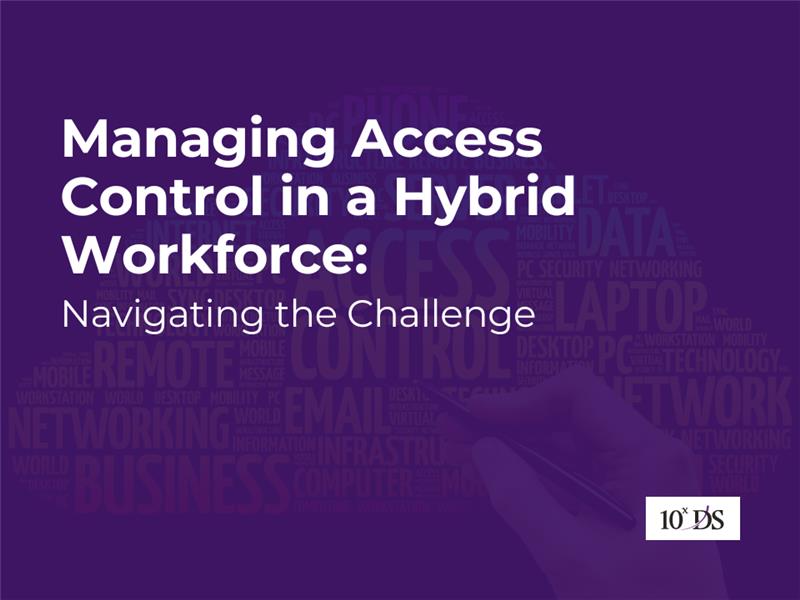
Managing Access Control in a Hybrid Workforce: Navigating the Challenge
The rapid adoption of remote work and hybrid workforce models has introduced a wide array of benefits and challenges for organizations across the globe. Companies are increasingly looking for ways to balance flexibility and accessibility while ensuring robust security measures are in place. In particular, one of the most critical aspects of managing a hybrid workforce is ensuring proper access control in cyber security. With employees working from different locations and devices, safeguarding sensitive company data and applications is more important than ever.
This blog explores how businesses can enhance accessibility and manage access control effectively for a hybrid workforce, ensuring that the right people have the right access to the right resources at the right time. Let’s dive into the key strategies and best practices.
The Need for Access Control in the Age of Hybrid Work
A hybrid workforce brings together remote employees and in-office teams, creating a diverse work environment. As businesses embrace this model, it becomes crucial to safeguard both on-premise and cloud-based resources. When employees have access to systems, applications, and networks from multiple devices and locations, the need for a secure and reliable method of access control in cyber security becomes paramount.
In cyber security, access control refers to the practice of regulating who can access specific resources within an organization and what actions they are allowed to perform. It is a critical component of any security strategy, ensuring that sensitive data is only accessible to authorized personnel while preventing unauthorized access.
With employees working from various locations, companies need to strike a balance between allowing flexible access and ensuring the security of their resources. Failure to implement proper access control can lead to potential data breaches, financial losses, and reputational damage.
Understanding the Different Types of Access Control
Before implementing access control measures, organizations must understand the different types of access control models available. These models are designed to ensure that only authorized users can access certain resources.
- Discretionary Access Control (DAC):
DAC allows the owner of the resource (e.g., a file, application, or system) to decide who has access to it. This model is flexible but can be prone to errors, especially in larger organizations where tracking individual permissions becomes more complex. - Mandatory Access Control (MAC):
MAC is a more rigid system that assigns access based on predefined security labels. Access decisions are made based on the classification of data (e.g., top secret, confidential, or public) and the security clearance level of the user. This model is often used in environments with highly sensitive data. - Role-Based Access Control (RBAC):
RBAC assigns access permissions based on a user’s role within the organization. For example, a manager may have access to certain resources that an entry-level employee cannot access. RBAC is highly effective for managing access in large organizations and can be easily integrated into a hybrid workforce. - Attribute-Based Access Control (ABAC):
ABAC is a more granular model that uses a variety of attributes to determine access. These attributes might include the user’s location, time of access, device type, or job function. ABAC is becoming increasingly popular as it allows organizations to make more context-based access decisions.
Each of these models offers unique advantages and challenges. Organizations must select the right model based on the type of data they manage, the scale of their workforce, and their specific security needs.
Key Strategies for Managing Access Control in Cyber Security
When managing a hybrid workforce, it is crucial to implement comprehensive access control in cyber security measures to ensure that employees can access the resources they need while minimizing potential security risks. Here are some strategies to enhance access control:
1. Implement Multi-Factor Authentication (MFA)
One of the simplest and most effective ways to secure access is through multi-factor authentication (MFA). MFA requires users to provide at least two forms of identification before gaining access to a system, such as a password and a fingerprint scan or a one-time PIN sent to a mobile device.
For a hybrid workforce, MFA is essential because it adds an extra layer of protection, especially when employees are accessing company systems from various devices and locations. Whether they are working from home, a coffee shop, or the office, MFA ensures that even if credentials are compromised, unauthorized access is still prevented.
2. Utilize Zero Trust Security Models
Zero Trust security is an approach that assumes no user, device, or system is trusted by default. Instead of granting broad access to internal systems, Zero Trust requires continuous verification of every user and device attempting to access company resources. This means that every login attempt, even from within the corporate network, must be authenticated and authorized.
A Zero Trust model is particularly effective for hybrid workforces because it ensures that even if an employee is working remotely or from an untrusted network, access is tightly controlled. It also reduces the risk of lateral movement in case a hacker compromises one part of the network.
3. Centralize Access Control Management
As the workforce becomes more decentralized, managing access becomes increasingly complex. Implementing a centralized access control system can help streamline access management across various platforms and applications.
By using a centralized identity and access management (IAM) solution, companies can manage user credentials, permissions, and authentication policies from a single platform. This enables IT teams to quickly modify or revoke access when necessary, ensuring that employees only have access to the resources they need. Centralized management also ensures that security policies are uniformly enforced, making it easier to monitor and audit access.
4. Regularly Review and Update Access Permissions
One of the most overlooked aspects of access control is the regular review and updating of access permissions. As employees join, change roles, or leave an organization, their access to company systems must be adjusted accordingly. Failure to do so can result in unauthorized access and security vulnerabilities.
Regular audits of user permissions help ensure that employees only have access to the resources they need to do their job. This is especially important in a hybrid workforce, where employees may move between remote and office-based work environments. Implementing an automated system that alerts IT teams to potential security risks related to access permissions can improve overall security.
Balancing Accessibility and Security
The challenge of managing access control for a hybrid workforce lies in balancing accessibility with security. While it’s essential to provide employees with the flexibility they need to work remotely, it’s equally important to ensure that access to sensitive data is tightly controlled.
Using tools like Single Sign-On (SSO), which allows users to access multiple applications with a single login, can help improve accessibility without compromising security. With SSO, employees only need to remember one set of credentials, which reduces the risk of weak passwords and simplifies the login process.
At the same time, implementing strict access control in cyber security policies ensures that employees can only access the data and applications necessary for their job. By regularly reviewing access permissions and leveraging technologies like MFA, Zero Trust, and IAM systems, organizations can maintain a secure environment while offering the flexibility that today’s hybrid workforce demands.
The Role of Training and Awareness
Even with the most advanced access control systems in place, human error remains one of the biggest security risks. Employees must be educated on the importance of strong password management, phishing attacks, and the need to follow security protocols when accessing company resources remotely.
Regular training sessions on cyber security best practices and access control in cyber security can help employees understand the risks associated with unauthorized access and encourage them to be more vigilant. Empowering employees with the knowledge they need to follow security protocols can significantly reduce the chances of security breaches.
Conclusion
As hybrid work models continue to evolve, managing access control in cyber security has become more critical than ever. By implementing robust access control measures, such as MFA, Zero Trust security, centralized IAM systems, and regular permission audits, organizations can ensure that their workforce remains both flexible and secure.
The hybrid workforce is here to stay, and businesses must adapt to the changing landscape by striking the right balance between accessibility and security. With the right access control in cyber security strategies, organizations can empower their teams to work productively and securely, no matter where they are located.
Talk to our Cybersecurity experts to learn more.


